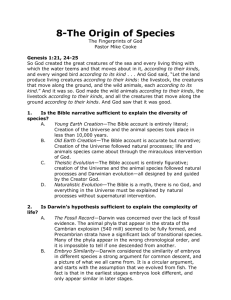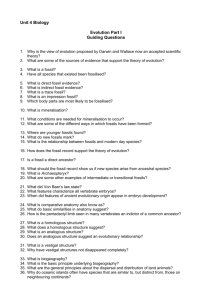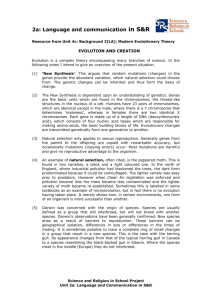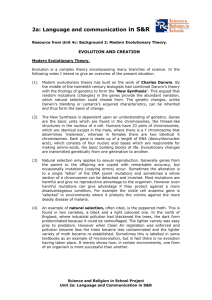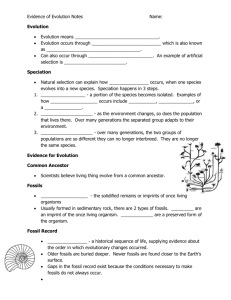THE 8 BEST SCIENTIFIC ARGUMENTS FOR CREATION – Scott
advertisement
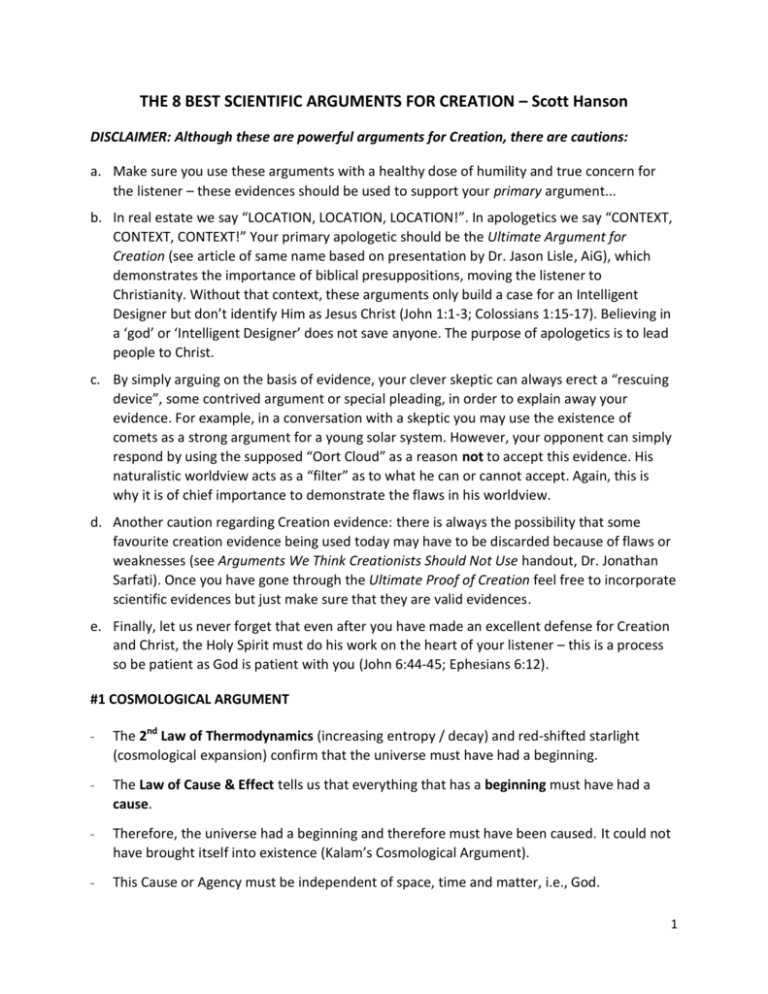
THE 8 BEST SCIENTIFIC ARGUMENTS FOR CREATION – Scott Hanson DISCLAIMER: Although these are powerful arguments for Creation, there are cautions: a. Make sure you use these arguments with a healthy dose of humility and true concern for the listener – these evidences should be used to support your primary argument... b. In real estate we say “LOCATION, LOCATION, LOCATION!”. In apologetics we say “CONTEXT, CONTEXT, CONTEXT!” Your primary apologetic should be the Ultimate Argument for Creation (see article of same name based on presentation by Dr. Jason Lisle, AiG), which demonstrates the importance of biblical presuppositions, moving the listener to Christianity. Without that context, these arguments only build a case for an Intelligent Designer but don’t identify Him as Jesus Christ (John 1:1-3; Colossians 1:15-17). Believing in a ‘god’ or ‘Intelligent Designer’ does not save anyone. The purpose of apologetics is to lead people to Christ. c. By simply arguing on the basis of evidence, your clever skeptic can always erect a “rescuing device”, some contrived argument or special pleading, in order to explain away your evidence. For example, in a conversation with a skeptic you may use the existence of comets as a strong argument for a young solar system. However, your opponent can simply respond by using the supposed “Oort Cloud” as a reason not to accept this evidence. His naturalistic worldview acts as a “filter” as to what he can or cannot accept. Again, this is why it is of chief importance to demonstrate the flaws in his worldview. d. Another caution regarding Creation evidence: there is always the possibility that some favourite creation evidence being used today may have to be discarded because of flaws or weaknesses (see Arguments We Think Creationists Should Not Use handout, Dr. Jonathan Sarfati). Once you have gone through the Ultimate Proof of Creation feel free to incorporate scientific evidences but just make sure that they are valid evidences. e. Finally, let us never forget that even after you have made an excellent defense for Creation and Christ, the Holy Spirit must do his work on the heart of your listener – this is a process so be patient as God is patient with you (John 6:44-45; Ephesians 6:12). #1 COSMOLOGICAL ARGUMENT The 2nd Law of Thermodynamics (increasing entropy / decay) and red-shifted starlight (cosmological expansion) confirm that the universe must have had a beginning. The Law of Cause & Effect tells us that everything that has a beginning must have had a cause. Therefore, the universe had a beginning and therefore must have been caused. It could not have brought itself into existence (Kalam’s Cosmological Argument). This Cause or Agency must be independent of space, time and matter, i.e., God. 1 #2 INFORMATION ARGUMENT: All life is based upon the molecule DNA (“Definitely No Accident!”) - the most complex, compact and efficient coded language / information system known. It is a true language, which the cell must properly read and decode in order to manufacture proteins. DNA, RNA (and their various derivatives) are highly complex molecules which do not occur in nature - they can only be produced by cells. In other words, their complexity is specified by the cell itself (i.e., to make a cell you need DNA; to make DNA you need a cell). All languages by definition must come from an intelligence. There is no known natural law through which matter can give rise to information. A code system is always the result of a mental process; matter cannot generate a code - DNA is the most complex language system known in the universe (Morse code comparison). Microbes-to-man (macro) evolution requires the addition of new, novel information into the DNA to progress from “protozoa to professor” - however there is no known naturalistic process that can generate these new instructions or blueprints. In fact, the 2nd Law of Thermodynamics as applied to information systems indicates that information will be progressively corrupted, degraded, and lost, not gained (mutations and natural selection cause a loss of information). Thus, a single, intelligent Cause, independent of our universe, must have brought the information into existence. We should therefore only observe plants and animals reproducing “after their own kind” and not creating new structures, which is what we observe (Genesis 1; Law of Biogenesis). There are several “chicken-and-egg” conundrums for the evolutionist: you need DNA to build proteins but there are numerous proteins (enzymes) that are vital for the manufacturing and transcribing of DNA... you need the DNA and the protein simultaneously, making any evolutionary story impossible. DNA synthase is a nanomachine in the mitochondria which manufactures ATP (the energy “currency” of the cell). However, in order to manufacture the ATP synthase, ATP is required! There are countless examples of this irreducible complexity, or “chicken-and-egg” evolutionary conundrum in cells. #3 TELEOLOGICAL (DESIGN) ARGUMENT Living organisms are superbly designed and exceedingly complex – even atheists like Richard Dawkins admit so much. Design is based upon 3 criteria: 1. Improbable object; 2. Recognizable pattern, 3. Specified complexity (i.e., the object/pattern was specified or intended). Design implies a Designer: the Designer must be uncreated and infinitely intelligent because all life is based upon information (note in John 1:1, the Creator, Jesus Christ, is called the logos, or Word, the source of ALL information). 2 Although Mount Rushmore, an arrowhead, a clock found on a path, or a totem pole display obvious design, living systems are exceedingly more complex and better designed. Examples such as ATP synthase motor, bioluminescence (nearly 100% efficient), bacterial flagellum, trilobite and lobster eyes, bat sonar, leech nervous system, blood clotting, photosynthesis, etc., show extreme complexity. Furthermore, ignoring the above problems, just the mathematical probability of even the ‘simplest cell’ (e.g., Mycoplasma genitalium) forming from non-living matter based on the random assemblage of amino acids and nucleic acids is essentially zero. Life is also “irreducibly complex”, meaning all the parts had to be together from the very beginning of the organism in order for it to exist (Michael Behe’s Darwin’s Black Box). Darwin admitted 150 years ago that if anyone could show him how the eye could not evolve in a step-by-step fashion (co-aptation) he would have to abandon his evolutionary ideas... well, 150 years later no answer is forthcoming. We observe that cells and sub-cellular structures (nano-machines like ATP synthase, protein manufacturing, organelles such as mitochondria and lysozomes, bacterial flagella, etc.) are incredibly complex and miniature structures that are extremely well engineered and designed. They cannot make themselves. Cells and smaller sub-components require cells to make them: a truly viscous circle for the evolutionist! Just as a commercial airliner is comprised of over 2 million non-flying parts, every cell is comprised of millions of subcomponents that all must be together in order to be useful. Nature cannot assemble a machine. There is an entire branch of science called bio-mimetics, involving the studying and 'copying' of living organisms in order to provide novel machines and materials for humans. Just one example among literally hundreds is the copying of the complex eye design of the lobster eye for the design of telescopic lenses. Intelligent scientists with all their planning and thought can only make inferior copies of what “nature” has supposedly made by random chance... think of the paradox! Richard Dawkins says that natural selection working over eons of time is the “designer”, but this random process can’t create anything - in fact it can only eliminate existing traits. Mutations (copying errors within the DNA) are also information-losing processes. Both natural selection and mutations only REDUCE the genetic information in an organism or population of organisms. They are insufficient to drive microbes-to-man evolution, and in fact are the opposite of evolution. Antibiotic resistance among bacteria or mutated fruit fly wings are NOT examples of “evolution in action” as purported, but are again examples of information loss: “super bugs” are misnamed, should be called “super wimps”. However, the design argument alone is insufficient to defend Christianity. How could a ‘good’ Designer allow death, suffering, bloodshed, cancer, natural disasters, and sadness in 3 this world? Some prominent Christian leaders of the past (e.g., Charles Templeton) abandoned Christianity because they could not reconcile how a supposed God of love could allow such atrocities. The answer is in Genesis. We understand that the perfect creation has been marred by sin and the curse (Romans 5:12; 8:19-22). The death and suffering are the consequences of sin. The problem with accepting the evolutionary “millions-of-years” interpretation of the fossil record is that it puts death, bloodshed, cancer, carnivory long before humans, making ‘god’ cruel and unjust, and removing man’s culpability. It also causes the death of Christ to have no value. Of course, that is certainly not the case and why we need to teach the young Earth Biblical view... design is not enough! Note about the 2nd Law of Thermodynamics (entropy) as applied to information systems: Information, order and complexity become more disordered and corrupted if left to themselves. Creationists often misrepresent the 2nd Law argument because they don’t fully understand it. However, when used properly, this is a very powerful argument for a Creator. Evolutionary counter arguments to the problem of entropy... a) Crystals (mineral or snowflakes) are examples of order/complexity in nature: Not applicable because the complexity in life is specified by DNA and contains information - these biomolecules could never form in nature. b) Open system of the sun allows energy to reach earth and supersede the effects of entropy: No. Raw energy will actually speed up the rate of decay. There must be a mechanism to capture energy and convert it into useable energy by the cell (photosynthesis, digestion). c) Acorns grow into oak trees and embryos grow into adults. These are examples of an increase in information (evolution): On the contrary. Acorns and embryos contain the exact same information as oak trees and adults, respectively. The difference is only in stage of development. There is no information increase here (very important when discussing abortion and a fetus’ humanity – has the same information from conception to adulthood!) #4 THE LAW OF BIOGENESIS (Omni Vivum Ex Vivo) Latin for "all life [is] from life“ meaning life ONLY comes from existing life after its own basic kind (baramin). No observation has ever contradicted this statement. Credit for this concept given to French Creationist microbiologist, Louis Pasteur. “After its kind” and “After their kind” are used 10 times in Genesis 1. Yet evolutionists believe (by faith) that one kind of animal turned into another kind of animal over millions of years in the unobservable past although it is impossible scientifically and is not observed in the fossil record. 4 #5 SIMILARITIES BETWEEN ORGANISMS Evolutionists argue that the similarity between creatures (e.g., vertebrate limbs) is evidence of descent from a common ancestor (homology): also known as Darwin’s “tree of life”. However, this interpretation is fraught with insoluble problems: homologous structures in very dissimilar creatures (e.g., octopus eye similar to human eye); different developmental pathways and gene sequences for the same structures (e.g., human vs. salamander digit formation); and contradictory molecular phylogenies (e.g., cytochrome B in different plants and animals) contradict Darwin’s “tree of life”. A far superior argument is for a Common Designer who put similar design features in various creatures with all sorts of interesting coincidences as part of His creativity. A good example of this: consider that all internal combustion automobiles did not originate from a common ancestor but were the result of common design features. #6 THE FOSSIL RECORD Darwin predicted that as you move from the ‘most ancient’ to the ‘most recent’ fossils, you should be able to see “evolution in action” in a gradual step-wise fashion from simple to complex; from few to several major phyla and increasing species (i.e., single cell to invertebrate to fish to amphibian to reptile to bird / mammal to human). He also logically expected that if this were true then you’d expect to see numerous inbetween, or transitional, forms in the fossil record. The actual observations indicate the exact opposite: the sudden appearance of fully formed, fully adapted organisms of all the major phyla (the so-called ‘Cambrian explosion’), with no progression from simple to complex, and no increase in species. Furthermore, we find countless types of fossil plants and animals which have living counterparts. When compared to each other they are virtually identical despite the supposed millions of years of evolution: referred to as ‘living fossils’, and examples of ‘evolutionary stasis’ - an evolutionary paradox and serious challenge to evolutionists. Darwin knew this deficiency to his model but felt it was due to the incompleteness in the fossil record and thought that over time the gaps would be filled in: 150 years later the problem is actually worse for Darwin and there exist even fewer supposed transitional forms (because the few examples of transitional fossils at his time have since been discarded by the evolutionary community (e.g., Archaeopteryx is now known by paleontologists to have been a flying bird with a mosaic of bird and some reptilian features, not a transitional form; in fact, “older” fossils of modern-type birds have been unearthed). Famed evolutionary paleontologist, Stephen J, Gould, once said: The extreme rarity of transitional forms in the fossil record persists as the trade secret of paleontology… to preserve our favored account of evolution by natural selection we view our data as so bad that we never see the very process we profess to study.” 5 #7 AGE OF THE EARTH & UNIVERSE 90% of the methods we can use to estimate the age of the Earth & universe give an age far younger than what evolutionists require even when we use evolutionists’ own uniformitarian assumptions. Some examples: galaxy wind-up, supernova remnants, early faint young sun paradox, internal heat of planets, short-period comets, moon recession, Earth’s rapidly declining magnetic field, salt and sediments in the ocean, rate of erosion of continents, retained helium in rocks, C-14 in coal and fossils, lack of erosion at sedimentary boundaries, evidence of rapid sedimentation and erosion, DNA in ancient in ‘ancient’ material, blood cells and soft tissue in dinosaur bones, written history and agriculture too recent, too few Stone Age fossils, etc. (we have entire presentations devoted to these evidences) Although these don’t ‘prove’ a young universe and Earth (only an eyewitness account / written record can do that: the Bible), they are consistent with a recent 6-Day recent Creation and global catastrophic Flood. Despite this overwhelming evidence, men continue to ignore Creation and the Flood and instead believe in gradualism and long ages in geology (uniformitarianism) and astronomy, which is propagated by the media and schools. This is a direct fulfillment of 2 Peter 3:3-7. KEY: The millions-of-years to the evolutionist is what the Resurrection is to the Christian: it is the critical foundation to their naturalistic worldview just as the Resurrection confirmed the deity of Jesus Christ. #8 ANTHROPIC PRINCIPLE Derived from the Greek word anthropos, or “man” - the term was coined by secular scientists. The principle is that the universe - our solar system and planet in particular appears to have been specifically designed with ‘man in mind’. The Earth is very unique and finely-tuned for complex life. We are indeed a “privileged planet”. There are too many precise variables that have to be just right in order for this to happen by chance. No evolutionary solution is logical. The probability by chance is zero. Examples: regularity of physical laws, the narrow conditions of atomic forces, gravity/distance relationship, properties of liquid water, ratio of water to continents, surface temperature, mass and diameter of Earth, atmosphere and ozone layer, brightness of sky, magnetic field, terrestrial planet plate tectonics, within galactic habitable zone, orbiting main sequence G2 dwarf star, protected by gas giants, within circumstellar habitable zone, nearly circular orbit around sun, precision of Earths’ orbit, orbited by a large moon, moderate rate of rotation, 23.5° tilt, ideal length of year, suns’ temperature and visible light, Earth’s magnetic field, etc. It just so happens that the very conditions necessary for life turn out to be the perfect conditions for observation: transparent atmosphere, our “LOCATION” between spiral arms 6 in a flattened galaxy, the emission of mainly visible light from the sun, essentially the same size for the sun and moon (eclipses), and so on. The mathematical probability that the conditions for both life and observablity would just happen to overlap the way they do is effectively zero and further confirmation of a Designer. Once an atheist, astronomer, Dr. Robert Jastrow, said: “The Universe was constructed within very narrow limits, in such a way that man could dwell in it. This result is called the anthropic principle. It is the most theistic result ever to come out of science, in my view.” CONCLUSION What we observe in God’s world agrees with what we read in God’s Word. It truly does require blind faith to be an atheist. People will nevertheless suppress the truth of this information (Romans 1:18-32) with what we call the “submerged beach ball” principle. This principle says that people have a moral problem and do not want to admit to their need for God and therefore will “suppress” the obvious truth of the Bible and the existence of their Creator. However, the evidence for a Creator is so monumental that it’s like a person in a pool straining to keep a beach ball submerged... the natural tendency is for the ball to pop up with great force when released: by suppressing the truth people are doing what is unnatural. Creation (Psalm 19:1-6; Romans 1:18-32) and Conscience (Ecclesiastes 3:11; Romans 2:14-15) together (General Revelation) bear witness to a Creator and man’s sinful state. It is sufficient to condemn all but insufficient to save any. The Written Word (2 Peter 1:20-21; 1 Thessalonians 2:13) and Living Word (John 1:1,14; Hebrews 1:1-3) are sufficient to save. These come only through the ministry of the gospel through the Word of God as well as sound Biblical apologetics. 7
